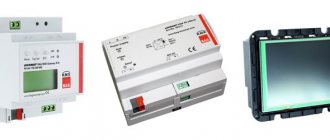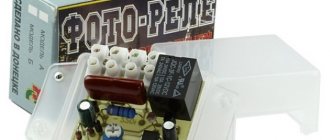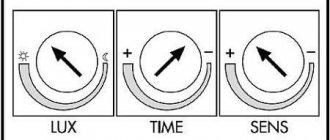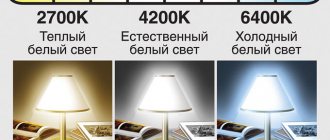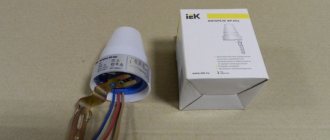Excessive energy costs make you think about possible ways to save. Using a light sensor, you can create the optimal level of lighting for your home and surrounding area without significant financial investment. Such devices have a well-thought-out design, ensuring timely switching on or off of the lighting system when darkness falls. They are divided into types. Having understood what it is and why such a device is needed, you can optimize the size of the invoices issued by the management organization.
Device
The device for automatically turning on the light includes a photo relay that ensures its operation under certain conditions. Photo relay includes:
- A housing designed to accommodate the remaining elements and correctly fix them relative to each other. For this purpose, special holes or other elements are provided in the housing to ensure reliable fixation;
- A photocell, which is a light-sensitive current sensor. From it, control pulses are supplied to the control element. The device may include a phototriac, phototransistor, LED, photothyristor;
- An electronic unit that includes a power source, an electromechanical relay, and a signal amplification device.
If light sensors are connected to devices with high power during operation, it includes a repeater of electromechanical relay contacts. Some models have the ability to adjust the response time. This allows you to prevent false alarms in the dark, for example, when accidentally hit by car headlights or other sources.
Making your own photo relay
Radio enthusiasts can try making their own relays using commercially available components. As already mentioned, the main element of the system is the photosensor: these can be photocells, transistors, diodes and photoresistors.
Let's consider creating a simple twilight switch based on a triac.
The proposed circuit diagram of a simple photo relay contains:
- Triac brand Quadrac Q60;
- FSK photocell;
- reference resistor labeled R1.
If there is no lighting, the triac switch opens and the light turns on. As the light level increases, the voltage shifts, and the brightness of the connected lamp drops until it turns off.
Let's complicate the device by adding a relay output. Added photo relay connection diagram:
It has the following components:
- V1 is the first signal amplification transistor. The latter contains resistor R1 and a photoresistor labeled PR1;
- VT2 - second transistor for monitoring relay K1;
- VD1 is a voltage shunt diode. It protects the transistors from voltage surges when the coil is turned off.
When PR1 is illuminated, a current sufficient to activate the relay will arise in the system.
The above circuit is very simple and will provide only rough operation of the sensor. But it can be supplemented with various elements that increase sensitivity and speed of operation, as well as setting threshold values.
How does it work
As soon as the illumination level decreases to a predetermined level, the photocell contacts close and the daylight sensor turns on the system. As the amount of natural light increases and the user-set level is reached, the contacts open and the system turns off.
The order of operation of the device and its capabilities largely depend on the design. The functionality of most modern devices is not limited to triggering at a certain level of light.
Interesting facts[edit | edit code]
- The light sensor resembles a kind of solar panel.
- 15 signal levels for a sensor located in an open space in good weather and 9 levels for a closed sensor (24 in total) make it possible to build a relatively accurate clock. But an hour during the day on such a clock will be longer (in real time), since with an open sensor, when the signal increases, the power change interval gradually increases, and when the power drops, it decreases (that is, the longest hour will be at noon when the signal is 15). A closed sensor operating at night has approximately the same interval.
- In the Lower World it sends a signal with a strength of 11, but in the Land there is no signal.
- The daylight sensor transmits the beacon beam.
- The sensor does not fall out when a TNT or creeper explodes.
- If you place a lamp (or several) so that it is a “window” into the room with the sensor, then at night (from 14360 game time to 21660) when it is turned on, the sensor stops working. As a result, if the lamp is powered from the sensor itself, it will blink. This happens because a lamp that is turned off is an opaque block, while a lamp that is turned on is transparent.
Main types
Light sensors can be interfaced with other automation devices. This significantly expands the functionality of the models and makes them more popular among consumers. Devices with:
- Timer. Such models allow you not only to adjust the level of illumination at which they operate, but also to set a time frame. In this case, the photo relay will operate in the time interval set by the user;
- Motion sensor. The best option for optimizing costs. Such devices are installed near pedestrian paths and in local areas where people periodically move or vehicles move. The daylight sensor is triggered if a large object is in the coverage area. As a result, at night, the location of the device will always be dark, but as soon as a car enters the site or a bird flies in, the device will work and the lighting will turn on;
- Programmable settings. Such devices have the most sophisticated technical equipment. They allow you to configure the operating mode at different time intervals. It is possible to regulate not only within a day, but also within weeks, months or a specific season. They also trigger when there is movement in the selected area.
Depending on the version, sensors can be:
- Infrared. The device is triggered when an object heated to a certain temperature enters the coverage area. They are equipped with infrared detectors. During operation, difficulties may arise if there is a pet within the device's coverage area; Acoustic. Such devices respond to sound. To turn on the device, a loud sound or creaking sound must be heard;
- Microwave. The devices are active type sensors. During operation, they generate waves in a certain microwave range and then receive them back. If there is a difference, the circuit is closed/opened and the device is subsequently turned on/off;
- Ultrasonic. According to the principle of their operation, they are comparable to microwave-type models. However, when choosing this option, you should remember that they can have some effect on pets; the presence of ultrasound can affect their behavior;
- Combined. Some models respond to several influencing factors at once. In terms of reliability, they are significantly superior to all the varieties listed above, but at the same time they are much more expensive.
New generation relays include astronomical sensors. They allow you to control the operation of lighting fixtures, but they work on a different principle. Such devices include a microcomputer that allows you to configure the operation of the device depending on its installation location. When setting up the device, GPS data for a specific locality is entered. Such devices automatically determine when the lighting lamps are turned on. This completely eliminates the possibility of false alarms typical of photocells. In addition, they are able to remain operational in any weather.
Astronomical timer
Motion sensors.
Hurry up to buy at a discount! This device is inherently different from a photo relay. Automatic switching on of lighting occurs at a specified time. The astro timer is programmed with the times when it gets dark and light in different regions. And he makes adjustments using GPS. You just need to enter the coordinates of its location, the current date and time. Based on the entered data, he selects the appropriate program and works.
This device has a number of advantages over photo relays. The latter can work in cloudy weather or, on the contrary, go out in the middle of the night due to light falling on it. The astronomical timer does not have such a drawback. It can be installed anywhere outdoors or indoors. On it you can shift the lighting on and off by 2-4 hours. Its only drawback is the high price.
Lighting control timer REV-302 with photo relay function
If you are choosing a device to illuminate streets or places where people stay for a short time (gate, toilet, etc.), a photo relay is suitable. But if you don’t want to depend on weather conditions and take care of the photocell, then it’s worth choosing the optimal astro-timer model for certain conditions and needs.
Advantages and disadvantages
Lighting sensors attract consumers with the opportunity to save energy. The advantages of using photocells include:
- Low current operation;
- Prompt operation. The device turns on and off almost instantly;
- High performance;
- Long service life.
When choosing a device like this, you should take into account that they do not work well in extreme conditions. At the same time, they place increased demands on the tightness of the housing. If moisture gets inside the device, there is a high probability that the sensor will fail and the sensor will not work due to oxidation of the contacts.
The device will not function properly if a layer of dirt and dust forms on its surface. That is why during operation it is necessary to constantly clean the devices.
Price issue
If you decide to install a light sensor for street lighting, the price should also interest you.
On the market, light sensors for day-night street lighting are expensive. And you can easily afford a regular light sensor. Choose the country of origin and decide what price you can afford. The range ranges from 2,000 to 10,000 rubles. You can choose for yourself how necessary this item is in your everyday life and how much you are willing to spend on it. After all, the principle of operation is quite simple, and everything can be done independently, with your own hands.
The main advantage of the most amazing sensors for street lighting is significant energy savings. In addition, it does not require a lot of money to maintain and maintain it. Install energy-saving light bulbs and enjoy the light in your home or street. It is possible to choose the light of the bulbs: warm or cold. New technologies allow you to install and configure the photocell yourself, which will significantly save your budget. A large selection of devices makes it possible to install sensors even with a small current supply, which is convenient in small summer cottages. A large selection of colors, shapes and materials from which the device is made allows you to easily blend into your interior and make it more harmonious and stylish.
Specifications
Light sensors for street lighting have technical characteristics that determine the possibility of their operation in certain conditions. For a photo relay, these parameters are:
- Supply voltage. 220 V models are installed in the apartment. If the installed system includes 12–36 V devices, a low-order circuit must be provided. This voltage is necessary to start the contactors of magnetic starters;
- Maximum permissible current. It is important when connecting devices operating from 220 V. In this case, an electric current passes through the contacts of the photo relay, intended to ensure the operation of the light source;
- The temperature at which the device can be operated. Outdoor models must remain operational over a wide temperature range. They must cope with the task in frost and extreme heat;
- Degree of protection. The outdoor device must have sufficient protection against moisture and water;
- Dimensions and weight. They are of fundamental importance when space is limited at the installation site.
Where can I buy
You can purchase lighting control equipment either in a specialized store or online in an online store. In the second case, the budget option for purchasing products on the Aliexpress website deserves special attention. For some video cameras there is an option for shipment from a warehouse in the Russian Federation; they can be received as quickly as possible; to do this, when ordering, select “Delivery from the Russian Federation”:
| Photo relay with automatic on/off | Photosensitive module for Arduino | Automatic control module for light switching |
| Street lamp with built-in light sensor | Adjustable photoresistor switch | Wall switch for lighting control |
Selecting a location
How effective the light sensor will be for turning on the light largely depends on its location. The box can be located inside or outside the house, depending on the purpose of the selected model.
When choosing a location for installing the device, you need to consider:
- Illumination. When choosing a location, you should avoid areas exposed to artificial light. If the area is located in close proximity to windows, streetlights, and is often illuminated by car headlights, it should be abandoned. At the same time, there should be no obstacles to the passage of natural light. Otherwise, the sensor will not work correctly;
- Reliability of fastening. The base on which the device is fixed must be able to support its weight. The fastening itself should not come into contact with components that do not have sufficient strength and reliability;
- Availability. During operation of the device, it may be necessary to monitor the condition. In addition, the selected site should allow for reliable fixation of the device. When choosing a location, preference is most often given to sites located at a height of 1.8–2 m. This height will allow for smooth installation and will not create difficulties during maintenance or cleaning. If the device is placed higher, a ladder will be required for installation and maintenance.
Installation work
The daylight sensor is installed according to the specific manufacturer's recommendations. A detailed algorithm of actions is described in the instructions supplied with the model.
The connection process usually does not cause serious difficulties. Many people install a light sensor in their home with their own hands. To install, you need to carefully inspect the device.
Each model will have three wires at the input: power, neutral, phase. Their colors may differ depending on the manufacturing company, but there will definitely be red, which is where the phase comes out. It is designed to connect the load.
Brown is used for power connection. Some manufacturers make it black. Zero is colored blue or green. The connection of the wires must be made in a special sealed distribution block.
If you plan to connect one device, the distribution block is located in close proximity to the relay. However, before you begin installation work, you should carefully read the recommendations of the manufacturer of the selected model. This will allow you to more accurately determine the location of all elements and the order of their installation.
In order to reduce energy costs, a daylight sensor is most often chosen with a motion sensor. In this case, the red wire is used to connect the motion sensor and the lamp. The remaining two are used to connect phase and zero. The connection procedure is described in more detail in the instructions for each model.
In the most general case, the work is performed in the following sequence:
- The power goes out. The shutdown procedure depends on the location of the work. Every owner must know how to do this in order to turn off the power to a house or apartment in case of an emergency;
- The photo relay is connected to the power wire;
- The ends of the wires are stripped. The length of the stripping should allow easy connection to the terminals;
- A hole is selected in the housing to connect the photo relay. If there is none, it is formed using a tool with a suitable cross-sectional size;
- All housing openings are sealed. This will prevent dirt, dust and moisture from getting inside. As a result, the installed daylight sensor will last much longer and will not create problems during operation;
- The device is connected in accordance with the recommendation src=»https://osensorax.ru/wp-content/uploads/2020/07/13-datchik-sveta-13.jpg» class=»aligncenter» width=»600″ height= "526"[/img]
- Wires are being prepared with which lighting fixtures will be connected to the device. The wires are cut to size, the ends are stripped, and they are connected to the required terminals according to the instructions supplied with the device;
- The photo relay is manually configured;
- The housing cover closes. Electric current is supplied to the device. The sensor is being tested.
During the installation process, the device often has to be moved, choosing a suitable spatial arrangement. In order not to waste time constantly unscrewing and tightening, you should not immediately fix the device “tightly”. This can be done once the final location has been selected.
The connection diagram may differ slightly. Each manufacturer tries to offer its own device that would turn on the light as dusk falls. In order not to encounter obvious difficulties, it is worth familiarizing yourself with the connection procedure before purchasing and assessing the possibility of using it at home. To perform installation work you do not need to have any special skills. However, during the installation process it is necessary to follow safety rules.
DIY light sensor in a car
Many car owners are wondering whether it is possible to make a light sensor in a car with their own hands, provided that it is not included in the standard equipment of the car. Such a modification is quite possible, and you can find ready-made kits on sale that can be easily installed if you have the complete instructions and certain skills in working with automotive electricals.
Video - light sensor in a Nexia car:
There is also a more complex option - independently, if you have the appropriate electrical parts, reproduce the light sensor circuit. In this case, a “solar battery”, that is, a photocell, from some household appliances (calculator, garden lamp, etc.) can be used as a photosensitive element.
Also, a regular diode from old electrical equipment can act as a photosensor; the upper part of the housing should be carefully cut off. The silicon inside the diode will then work as a photocell. Of course, you will also need a relay that will close the electrical circuit when the light level decreases.
Connection and subsequent configuration of the sensor
Most modern devices allow you to select the sensitivity of the device and determine the response threshold. As a rule, light sensor manufacturers place the adjustment at the bottom of the relay.
Adjusting the photosensitivity light sensor is carried out in the dark. Wait for the time when the device should start working in order to connect artificial lighting. Having found a disk that regulates the light on the bottom of the sensor, they begin to turn it, making the device work.
Most often, the manufacturer indicates a minus sign on the body, then rotating in a given direction reduces the sensitivity of the sensor. The device will only operate in complete darkness. If this option is not suitable, the disk should be rotated in the opposite direction. This will improve sensitivity.
In addition to adjusting the photo relay itself, you should configure the devices associated with it. In this case, the entire system will work properly.
What it is?
It is widespread to use this technique to turn on the lights when it gets dark on:
- local areas;
- pedestrian paths;
- access roads;
- internal passages.
Also, with the help of automatic regulators, it is possible to provide ideal illumination of building structures and decorative structures. A description of the use of light sensors would be incomplete without mentioning the twilight switch. Sometimes it is also called a twilight relay. The main purpose of this element is to fully automate lighting. Such systems operate not only at the end of daylight, but also in gloomy, cloudy weather.
As soon as the clouds clear, the light turns off or is reduced to a minimum
This is especially important precisely at those moments when the light changes sharply. Even the most responsible and attentive people are unlikely to be able to react as quickly as automation
Modern twilight relays can be configured for specific action programs. Of course, you can manually turn off the light if something happens that is not provided for by the program.
Comparison of models
For clarity, let’s create a table of the sensors we reviewed with their characteristics.
| Model | Viewing angle, degrees | Range, m | Maximum load power, W | Installation height, m | Dimensions, mm | Weight, g |
| Orbis 360 degrees CIRCUMAT PRO CR white DU OB134912 | 360 | 30 | 2200 | 7 | 140x80x175 | 340 |
| IP44 Brennenstuhl 1170900(180 degrees) | 180 | 12 | 1000 | 7 | 100x150x75 | 220 |
| Feron Sen 30 230V 500W 5-8 cm 30 with white cable 1.5 m 22068 | 30 | 0,08 | 500 | — | 79x35x19 | 61 |
| TDM DDM-02 SQ0324-0021 | 180 | 8 | 1200 | 3,5 | 86.4x60.4x98 | 180 |
| Camelion LX-28A 6438 | 360 | 6 | 1200 | 2,5 | 120x65x120 | 149 |
| Rev Ritter "Action" 110 | 110 | 12 | 1000 | 2,5 | 120x65x120 | 185 |
| EKF PROxima dd-ms-22B | 360 | 6 | 2000 | 4 | 115x25x115 | 110 |




